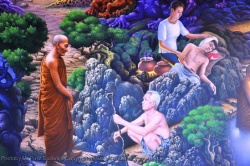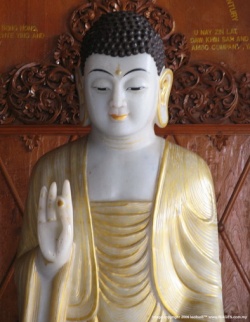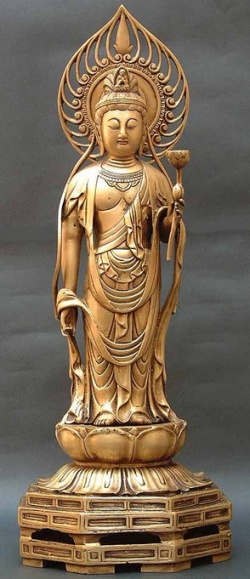Eight Minds
One of the most interesting teachings within the Dharma when I was first learning was on the topic of the Eight Minds. The Eight Minds are also known as the Eight Consciousnesses. It's about the psychology of our brain from the perspective of Buddhism.
To begin our look on the Eight Minds, I'd like to share with you an excerpt from the book, The Purpose of Life by Tamotsu Asakura.
The science of psychology deals with the structure of our minds.
Modern psychology teaches that there is subconsciousness beneath our consciousness and that further below that, lies "depth psychology."
You may have heard about the subconscious but you may not have heard of the term "depth psychology." Would anyone believe if he was told that Sakyamuni Buddha had already revealed this level of psychology 2,600 years ago, although 20th Century psychology, at long last, has just begun to elucidate it?
In the 80s, Japan and the United States were seriously competing with each other on the development of a fifth generation computer, also called artificial intelligence or A.I. for short.
Professor Marvin Minsky, of the Massachusetts Institute of Technology and a worldwide authority on A.I., is engaged in researching Buddhist scriptures -- stating that the study of Buddhism is essential for experimenting on the development of A.I. Why Buddhism in the computer?
He explained that for the development of A.I., it became naturally necessary to do the research on the nature of man's mind. However, modern psychology did not give thorough instructions on it. He therefore researched the religions of the world -- since they specialized in the mind -- to see if there was any religion that gave instructions regarding the structure of the mind. As a consequence, he found that most religions hardly gave any information on it. However, in the Buddhist scriptures, it was taught in detail. Sakyamuni Buddha was truly an exceptional psychologist. [Minsky] found that Buddhist scriptures were unsurpassed texts for the development of computers.
What Professor Minsky used for his thesis on A.I. was this teaching on the Eight Minds. Let's look at what he discovered.
The Eight Minds
1.) Sight Consciousness -- Mind of the eyes. This is the mind that perceives what we see and enjoys from all the sights
2.) Hearing Consciousness -- Mind of our ears. The mind that detects the sounds we hear. We listen through this mind and with it can enjoy music.
3.) Smell Consciousness -- Mind of the nose. The mind that detects odors and pleasing fragrances.
4.) Taste Consciousness -- Mind of the tongue. The mind that perceives and tastes between sweet and savory. The joy experienced from fine cuisine.
5.) Touch Consciousness -- Mind of the body. The mind that discriminates between textures and temperatures. It perceives between hot and cold also between tough and soft. The Mind of the Body also includes the exhilaration from sports and dancing. It also includes the soothing sensation of silk or a cool breeze.
6.) Thought Consciousness -- This is the mind that thinks, memorizes, and dreams. It is also the mind that integrates the first five consciousness and judges collectively between them. It is the mind that enjoys reading.
7.) Manas Consciouness -- It is the mind that makes us feel attachment to various people and things. It is the mind of "I." It goes hand-in-hand with the Alaya Consciousness.
8.) Alaya Consciousness -- If you read over my posts on the Law and Cause and Effect, you learned a bit about this as Alaya Mind. It's also known as Storehouse Consciousness as it is the storehouse of our karma.
You may have heard of the Himalaya Mountains. Well, the meaning there is Snow Storehouse. I thought that was really amazing. Just imagine how vast our karma storehouse is! Alaya Consciousness is our True Mind. This mind is at the very bottom of our Thought Consciousness.
The first six minds are widely-known and easy to understand because we can recognize them. Here's another excerpt from Mr. Asakura's book so we can get a better grasp on the last two minds. (Note: words in brackets are English translations of the Japanese terms used in the original work. )
Manas Consciouness and Alaya Consciousness do not appear on the surface, and therefore we are not aware that we have such minds. They are, so to speak, the minds that are concealed at the bottom of Thought Consciousness.
Buddhism is the study of the mind, but Buddhist universities put strong emphasis on the subjects of Manas Consciousness and Alaya Consciousness. These two complicated minds, it is said, take eight years to comprehend, even if one should study with serious determination. It is that difficult.
Then what sort of mind is (Alaya Consciousness)? ... What things are stored in the Alaya Consciousness? Our karma is stored in it. What is karma? In plain language, it is the energy of the deeds produced by the body, mouth, and mind.
In Buddhism what we think in our mind is considered as one kind of deed. We perform all sorts of deeds, both good and evil, and they are all stored as seeds which, in the future, produce effects in accordance with the Law of Cause and Effect. A good act produces a good effect; an evil act produces an evil effect, accordingly. One's acts bring the effects back to oneself.
In Buddhism, these effects are called karma-seeds, and the storage of these seeds is the Alaya Consciousness. A karma-seed is energy which is colorless and formless from the beginning ... the Alaya Consciousness is also a colorless and formless existence. Within the Alaya Consciousness are stored all the karma-seeds one has practiced from his beginningless past as well as the karma-seeds of his acts since his birth into the human world of his present.
The eight kinds of consciousness may be divided into two categories -- Thought Consciousness and Alaya Consciousness. The first five kinds of consciousness are subordinate to Thought Consciousness and the seventh, Manas Consciousness, could be incorporated into Alaya Consciousness.
People today are only aware of Thought Consciousness.
Mr. Asakura goes on to explain that the Alaya Mind is our fundamental consciousness. It is at the very bottom of our Thought Consciousness and even has control it.
We are taught right and wrong through our education and our upbringing by our parents. This knowledge is stored in our Thought Consciousness. However, the Alaya Consciousness ignores all ethics and morals because it is a deeper mind. Although one may be aware through Thought Consciousness that it's wrong to do something, the Alaya Mind still has the command to say, "Do it anyway."
As we age, the pleasures of the six senses begins to decline. However, people will always keep looking for something stimulating as there is no end to our desire while we're alive. These six minds will finally perish with the body at the time of death. But the Alaya Consciousness, "filled with one's lifetime karmic-evils, continues to journey into the world of the afterlife."
That is why in Buddhism, the goal is to awaken this Alaya Consciousness before we die. Once we deeply realize the existence of this mind, we can feel pure joy and fulfill our true life's purpose. It is how we come to know our True Self and receive absolute happiness.



